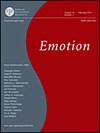Accuracy and bias in the social perception of envy.
IF 3.6
2区 心理学
Q1 PSYCHOLOGY, EXPERIMENTAL
引用次数: 12
Abstract
Research converges on the notion that when people feel envy, they disguise it toward others. This implies that a person's envy in a given situation cannot be accurately perceived by peers, as envy lacks a specific display that could be used as a perceptual cue. In contrast to this reasoning, research supports that envy contributes to the regulation of status hierarchies. If envy threatens status positions, people should be highly attentive to identify enviers. The combination of the two led us to expect that (a) state envy is difficult to accurately perceive in unacquainted persons and (b) dispositional enviers can be accurately identified by acquaintances. To investigate these hypotheses, we used actor-partner interdependence models to disentangle accuracy and bias in the perception of state and trait envy. In Study 1, 436 unacquainted dyad members competed against each other and rated their own and the partner's state envy. Perception bias was significantly positive, yet perception accuracy was nonsignificant. In Study 2, 502 acquainted dyad members rated their own and the partner's dispositional benign and malicious envy as well as trait authentic and hubristic pride. Accuracy coefficients were positive for dispositional benign and malicious envy and robust when controlling for trait authentic and hubristic pride. Moreover, accuracy for dispositional benign envy increased with the depth of the relationship. We conclude that enviers might be identifiable but only after extended contact and discuss how this contributes to research on the ambiguous experience of being envied. (PsycINFO Database Record (c) 2019 APA, all rights reserved).社会对嫉妒认知的准确性和偏见。
研究表明,当人们感到嫉妒时,他们会向他人掩饰嫉妒。这意味着,一个人在特定情况下的嫉妒无法被同龄人准确感知,因为嫉妒缺乏可作为感知线索的特定表现。与这种推理相反,研究支持嫉妒有助于调节地位等级制度。如果嫉妒威胁到地位,人们应该高度注意识别嫉妒者。这两者的结合使我们期望(a)状态嫉妒在不认识的人身上很难准确感知,(b)性格嫉妒者可以被熟人准确识别。为了研究这些假设,我们使用行动者-伴侣相互依存模型来理清状态和特质嫉妒感知的准确性和偏见。在研究1中,436名不熟悉的二人组成员相互竞争,并对自己和伴侣的嫉妒程度进行评分。感知偏差显著为正,但感知准确性不显著。在研究2中,502名熟悉的二人组成员对自己和伴侣的善意和恶意嫉妒以及真实和傲慢的自豪感进行了评价。准确度系数对于倾向性的善意和恶意嫉妒是正的,对于控制特质真实和傲慢的自豪感是稳健的。此外,性格善意嫉妒的准确性随着关系的深度而增加。我们得出结论,嫉妒者可能是可识别的,但只有在长期接触后,并讨论了这如何有助于研究被嫉妒的模糊体验。(PsycINFO数据库记录(c)2019 APA,保留所有权利)。
本文章由计算机程序翻译,如有差异,请以英文原文为准。
求助全文
约1分钟内获得全文
求助全文
来源期刊

Emotion
PSYCHOLOGY, EXPERIMENTAL-
CiteScore
8.40
自引率
7.10%
发文量
325
审稿时长
8 weeks
期刊介绍:
Emotion publishes significant contributions to the study of emotion from a wide range of theoretical traditions and research domains. The journal includes articles that advance knowledge and theory about all aspects of emotional processes, including reports of substantial empirical studies, scholarly reviews, and major theoretical articles. Submissions from all domains of emotion research are encouraged, including studies focusing on cultural, social, temperament and personality, cognitive, developmental, health, or biological variables that affect or are affected by emotional functioning. Both laboratory and field studies are appropriate for the journal, as are neuroimaging studies of emotional processes.
 求助内容:
求助内容: 应助结果提醒方式:
应助结果提醒方式:


